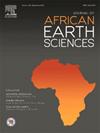埃及苏伊斯湾盆地Rabeh-East油田早中新世(burdigian) Rudeis组层序地层与岩石物理综合分析
IF 2.2
4区 地球科学
Q2 GEOSCIENCES, MULTIDISCIPLINARY
引用次数: 0
摘要
Rudeis组在苏伊士湾的油气勘探中起着关键作用,是该地区的主要储层目标之一。本研究的主要目的是将高分辨率层序地层解释与详细的岩石物理分析相结合,以更好地了解Rabeh-East油田下中新统Rudeis组的沉积构型和储层潜力。本研究使用的数据集包括四口井(RE-11、RE-22、TANAN-1和TAWOOS-1)的电缆测井和地震剖面,并辅以RE-22井的综合生物地层报告。在4560 ~ 4632英尺(1389.9 ~ 1411.8米)之间,以砂质灰岩和钙质砂岩为特征,其岩石物理参数为:总孔隙度(ΦT)为19%,有效孔隙度(ΦE)为13%,含水饱和度(SW)为48%,体积水(BVW)为9%。生物地层分析鉴定出5个浮游有孔虫带(N6/5、N6b、N6c、N7、N8a)和2个钙质纳米化石带(NN3、NN4),将鲁德斯组确定为早中新世(Burdigalian)。该分带可将层序划分为3个三级层序(DS1-DS3),并以4个层序边界(SB1-SB4)为界。每个沉积层序包括海侵和高地体系域,反映了与构造和/或海平面变化有关的相对海平面变化。分析表明,潜在储层形成于海侵体系域,以海平面上升时期砂质相流入为标志。综合以上因素,研究区远景区形成于TST期,在海平面整体上升的过程中,砂相侵入较为明显。本文章由计算机程序翻译,如有差异,请以英文原文为准。
Integrated sequence stratigraphic and petrophysical analyses to evaluate the reservoir potential of the Early Miocene (Burdigalian) Rudeis Formation in Rabeh-East Field, Gulf of Suez Basin, Egypt
The Rudeis Formation plays a pivotal role in hydrocarbon exploration within the Gulf of Suez, serving as one of the primary reservoir targets in the region. The principal objective of this study is to integrate high-resolution sequence stratigraphic interpretation with detailed petrophysical analysis to better understand the depositional architecture and reservoir potential of the Lower Miocene Rudeis Formation in the Rabeh-East Field. The dataset utilized in this research includes a combination of wireline logs and seismic profiles from four wells (RE-11, RE-22, TANAN-1, and TAWOOS-1) supplemented by a comprehensive biostratigraphic report prepared for well RE-22. A promising hydrocarbon zone occurs between 4560 and 4632 ft (1389.9 - 1411.8 m), characterized by sandy limestone and calcareous sandstone, with petrophysical parameters: total porosity (ΦT) of 19 %, effective porosity (ΦE) of 13 %, water saturation (SW) of 48 %, and bulk volume of water (BVW) of 9 %. Biostratigraphic analysis identified five planktonic foraminiferal zones (N6/5, N6b, N6c, N7, N8a) and two calcareous nannofossil zones (NN3, NN4), assigning the Rudeis Formation to the Early Miocene (Burdigalian). This zonation allows the succession to be divided into three third-order depositional sequences (DS1–DS3), bounded by four sequence boundaries (SB1–SB4). Each depositional sequence includes transgressive and highstand systems tracts, reflecting relative sea-level variations linked to tectonic and/or eustatic changes. The analysis indicates that the potential reservoir zone was deposited during a transgressive systems tract, marked by the influx of sandy facies during a sea-level rise. Considering all these variables, our findings revealed that the study area's prospective zone was created during the TST with a noticeable invasion of sandy facies during the overall rise in sea level position.
求助全文
通过发布文献求助,成功后即可免费获取论文全文。
去求助
来源期刊

Journal of African Earth Sciences
地学-地球科学综合
CiteScore
4.70
自引率
4.30%
发文量
240
审稿时长
12 months
期刊介绍:
The Journal of African Earth Sciences sees itself as the prime geological journal for all aspects of the Earth Sciences about the African plate. Papers dealing with peripheral areas are welcome if they demonstrate a tight link with Africa.
The Journal publishes high quality, peer-reviewed scientific papers. It is devoted primarily to research papers but short communications relating to new developments of broad interest, reviews and book reviews will also be considered. Papers must have international appeal and should present work of more regional than local significance and dealing with well identified and justified scientific questions. Specialised technical papers, analytical or exploration reports must be avoided. Papers on applied geology should preferably be linked to such core disciplines and must be addressed to a more general geoscientific audience.
 求助内容:
求助内容: 应助结果提醒方式:
应助结果提醒方式:


